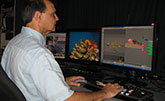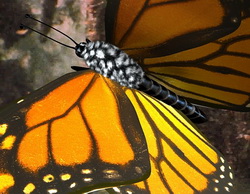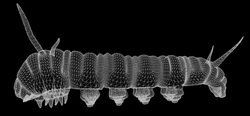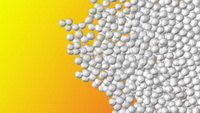 Intelligent Design
Intelligent Design
Virtual Biology: An Interview with Illustra Animator Joseph Condeelis
The documentary Metamorphosis, like previous Illustra masterpieces, contains visualizations of biological systems that cannot be photographed in real time. Joseph Condeelis of Light Productions is the genius behind many of the animated sequences.
Joseph, the accolades for Metamorphosis keep coming in, in part for the superb graphics. Tell us about your experience working with Illustra Media.
 First it has to be said, in my profession, working with Producer-Director Lad Allen is like a trip to Hawaii. Unlike most of my clients, Lad does his homework and provides me, the animator, with all the resources necessary to understand what he wants. Then he stays with me and keeps in contact until the product is perfected. Working with Jerry Harned, Tim Eaton and the rest of the Illustra staff is also a treat.
First it has to be said, in my profession, working with Producer-Director Lad Allen is like a trip to Hawaii. Unlike most of my clients, Lad does his homework and provides me, the animator, with all the resources necessary to understand what he wants. Then he stays with me and keeps in contact until the product is perfected. Working with Jerry Harned, Tim Eaton and the rest of the Illustra staff is also a treat.
I hear you gave names to some of your animated “cast of characters.” Is there a butterfly with a name?
Rex, the star, is our Monarch Butterfly. Rex appears throughout the film unnoticed (which I guess is the highest compliment to an animator). Animating Rex’s wing motion was really hard. I spent over 30 days filming a live one (many of those shots ended up in the show) and then slowing down the speed one frame at a time to study the flight path and wing motion. Next time you see a  butterfly flying notice how radical they fly! They look like a black dot flying up, down, left and right all in a split second. And when you add gusts of wind, well – to be nice, let’s just say it’s challenging! Lad sent me a high-resolution clip of a monarch he shot years before at 1,000 frames a second. With resources like that you can better see the ripples the wind makes in the wing as it flaps, and the frame-by-frame variations in the up and down motion. And to make matters worse, after you’ve nailed the animation, any time the camera gets moved, you had to rework all that authentic animation again! All that said, Rex ended up majestic and magical. He also has a nice set of hair that makes me envious.
butterfly flying notice how radical they fly! They look like a black dot flying up, down, left and right all in a split second. And when you add gusts of wind, well – to be nice, let’s just say it’s challenging! Lad sent me a high-resolution clip of a monarch he shot years before at 1,000 frames a second. With resources like that you can better see the ripples the wind makes in the wing as it flaps, and the frame-by-frame variations in the up and down motion. And to make matters worse, after you’ve nailed the animation, any time the camera gets moved, you had to rework all that authentic animation again! All that said, Rex ended up majestic and magical. He also has a nice set of hair that makes me envious.
It’s amazing the detail you put into them. Who’s another character you brought to animated life?
Scooter is our caterpillar. Sometimes we animators spend a lot of time on things that never make it in the show or get very short stage time. Scooter is one of them. He’s an eating machine (you can hear him eating), and he does get along nicely. He has a hand-painted coat of colors on his velvet skin enhanced with a soft UV map. We gave him all the components and precursors waiting for the trigger to grow into compound eyes, antennae, six legs, a proboscis and (not to leave out the most majestic part of all), four wings. But in the final cut, you only see Scooter in a wire frame frozen still for about five seconds at time 10:40. It’s kind of unfair the little guy gets such a short time on stage; it seems to me, without Scooter, there would be no Rex, right? Yet I have to agree with Lad Allen, “When you can film the real thing, animation falls second.”
coat of colors on his velvet skin enhanced with a soft UV map. We gave him all the components and precursors waiting for the trigger to grow into compound eyes, antennae, six legs, a proboscis and (not to leave out the most majestic part of all), four wings. But in the final cut, you only see Scooter in a wire frame frozen still for about five seconds at time 10:40. It’s kind of unfair the little guy gets such a short time on stage; it seems to me, without Scooter, there would be no Rex, right? Yet I have to agree with Lad Allen, “When you can film the real thing, animation falls second.”
What were some other animation projects you worked on?
We worked on showing how the digital code in DNA points powerfully to a designing intelligence behind the origin of life. There are seven shots of the nucleotides forming a long chain. What you are looking at as you watch the letters correctly line up with each  other is authentic and accurate – I mean, this is what the “letters” of the digital code really look like. The red letter “G” (guanine) you see in the forming chain of DNA is highlighted to show a mutation – a mistake. When you think of design, I don’t think it gets any better than this. It’s safe to say that the Space Shuttle we designed is like a tinker toy compared to the DNA code in each of our trillions of cells. Undirected random variation and natural selection do not produce systems of codes like these.
other is authentic and accurate – I mean, this is what the “letters” of the digital code really look like. The red letter “G” (guanine) you see in the forming chain of DNA is highlighted to show a mutation – a mistake. When you think of design, I don’t think it gets any better than this. It’s safe to say that the Space Shuttle we designed is like a tinker toy compared to the DNA code in each of our trillions of cells. Undirected random variation and natural selection do not produce systems of codes like these.
What other animated things should we watch for in the film?
Look for the larval wing, leg, and eye. Again, Lad Allen makes my job so much easier by providing me with the MRI resources to morph each stage. As with most of all animation, morphing is one of the most time-consuming aspects.
Give us a glimpse at how hard it is to simulate biological systems.
Apoptosis (programmed cell death): I must say that rendering apoptosis was the most challenging of all the animation in Metamorphosis. There are very few accurate resources to work from, but I think our final attempt at it was depicted well in the film (see Jerry Harned interview for more).
Spreading Wing Cell Division: Like apoptosis, the portrayal of cell division in the wing was really hard to figure out. I think I  spent more time testing out a faster way to animate it than actually getting it done, but with no success. I had to use “Hypervoxels,” which allow you to render different particle animation effects, in this case a cluster of cells dividing to become the wing of the butterfly. You can’t see Hypervoxels, so how do you animate them? To make matters even worse, when you use a blending plug-in to make them look like two drops of water pulling apart, if you’re just a hair too close, they will stick together and look like a figure 8. That’s no big deal if you just need to make one cell dividing into two, but in this case, it was hundreds of thousands. Let’s not talk about this anymore… I’m starting to remember how stressed I felt on that project!
spent more time testing out a faster way to animate it than actually getting it done, but with no success. I had to use “Hypervoxels,” which allow you to render different particle animation effects, in this case a cluster of cells dividing to become the wing of the butterfly. You can’t see Hypervoxels, so how do you animate them? To make matters even worse, when you use a blending plug-in to make them look like two drops of water pulling apart, if you’re just a hair too close, they will stick together and look like a figure 8. That’s no big deal if you just need to make one cell dividing into two, but in this case, it was hundreds of thousands. Let’s not talk about this anymore… I’m starting to remember how stressed I felt on that project!
 Helicopter: For the helicopter dust, again we used the magic of Hypervoxels. It’s hard to see in the film but if you look close you’ll see four very thin twisters whirling around in the cloud of dust as pictured here.
Helicopter: For the helicopter dust, again we used the magic of Hypervoxels. It’s hard to see in the film but if you look close you’ll see four very thin twisters whirling around in the cloud of dust as pictured here.
How has animating biological systems affected your view of nature?
For me, the death and renewal that goes on inside the chrysalis is a God thing. Over the last seven years I have spent most of my life animating molecular biology. I am not a practicing scientist, but I have to say I am so awed, so excited about all I am learning that I feel I am witnessing the handprint of God. It’s truly amazing to learn and see the universe living inside each of our trillions of cells. I truly believe that if Darwin had had the tools we have available today, he would be embarrassed to even consider a theory about life emerging through a multitude of small, undirected steps.
_____________
 To learn more about butterflies and the evidence they reveal for intelligent design, visit Metamorphosisthefilm.com, where you can watch the trailer and order this outstanding film, now available in both DVD and Blu-Ray formats. While there, be sure to download the free companion e-book, Metamorphosis: The Case for Intelligent Design in a Chrysalis, edited by David Klinghoffer — a beautiful and informative resource to enhance your appreciation of butterflies.
To learn more about butterflies and the evidence they reveal for intelligent design, visit Metamorphosisthefilm.com, where you can watch the trailer and order this outstanding film, now available in both DVD and Blu-Ray formats. While there, be sure to download the free companion e-book, Metamorphosis: The Case for Intelligent Design in a Chrysalis, edited by David Klinghoffer — a beautiful and informative resource to enhance your appreciation of butterflies.
